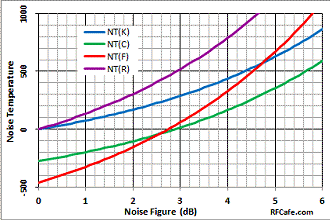Noise Figure <--> Noise Temperature Calculator |
|||||||||||||||||||||||||||||||||||||||||||||||||||||||||||||||||||||||||||||||||||||||
This JavaScript calculator converts between noise figure and the equivalent noise temperature. Conversion Between Noise Figure Noise Temperature (K) = TREF * Noise Figure (dB) = 10 * log10
Note that unless otherwise specified TRef = 290 K Numerical inputs are not error trapped but are converted to absolute values (no negatives). Just what is noise temperature and why is it used? Simply put, noise temperature is the temperature at which a resistor at the component / system input would generate the same amount of noise measured at the output. It goes back to the familiar kTB calculation for thermal noise power. Noise temperature is often used in calculating the overall noise figure of a system that includes an antenna at the input. That is because strictly speaking, a 1-port device like an antenna cannot be defined in terms of noise figure. If you begin with a system at room temperature (290 K) and add a component at the input that itself has a noise temperature of 290 K, the doubling of noise power increases the overall noise figure by 3 dB (2*290-290=290). A 6 dB increase is a 4x increase in noise power (4*290-290=870). Cascaded noise temperature is done just like with noise figure. Related Pages on RF Cafe - Noise Figure <--> Noise Temperature Calculator |
|||||||||||||||||||||||||||||||||||||||||||||||||||||||||||||||||||||||||||||||||||||||
